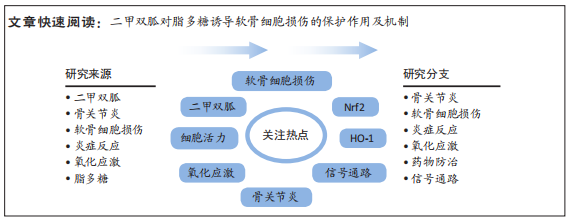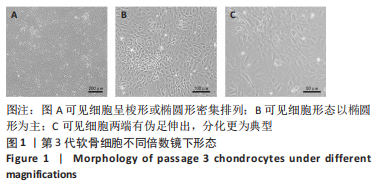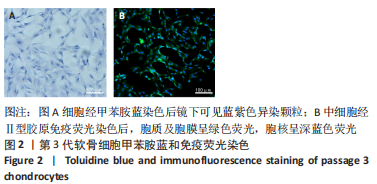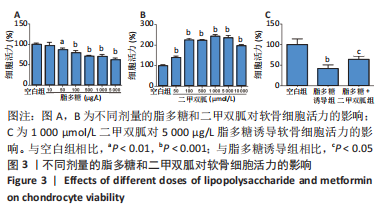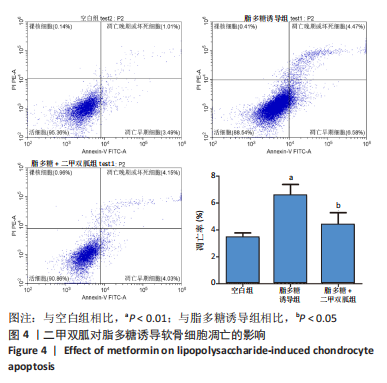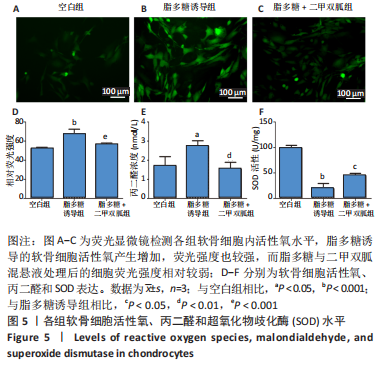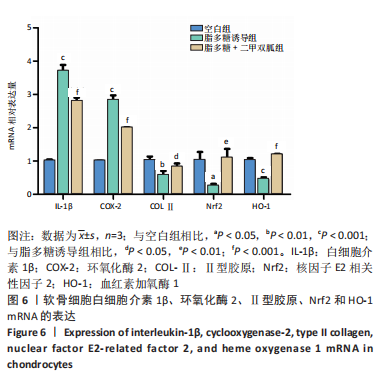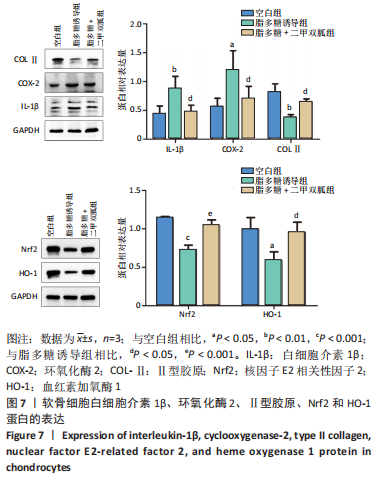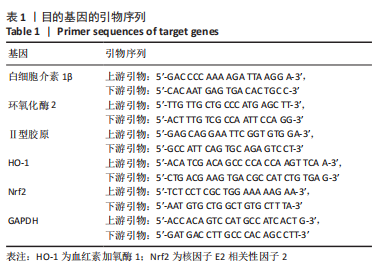[1] LI J, ZHANG B, LIU WX, et al. Metformin limits osteoarthritis development and progression through activation of AMPK signalling. Ann Rheum Dis. 2020;79(5):635-645.
[2] ANSARI MY, AHMAD N, HAQQI TM. Oxidative stress and inflammation in osteoarthritis pathogenesis: Role of polyphenols. Biomed Pharmacother. 2020;129:110452.
[3] WANG T, HE C. Pro-inflammatory cytokines: The link between obesity and osteoarthritis. Cytokine Growth Factor Rev. 2018;44:38-50.
[4] WANG Y, ZHANG JJ, YANG WR, et al. Lipopolysaccharide-induced expression of FAS ligand in cultured immature boar sertoli cells through the regulation of pro-inflammatory cytokines and miR-187. Mol Reprod Dev. 2015;82(11):880-891.
[5] HENNIG P, GARSTKIEWICZ M, GROSSI S, et al. The Crosstalk between Nrf2 and Inflammasomes. Int J Mol Sci. 2018;19(2):562.
[6] LOBODA A, DAMULEWICZ M, PYZA E, et al. Role of Nrf2/HO-1 system in development, oxidative stress response and diseases: an evolutionarily conserved mechanism. Cell Mol Life Sci. 2016;73(17):3221-3247.
[7] CHEN Z, ZHONG H, WEI J, et al. Inhibition of Nrf2/HO-1 signaling leads to increased activation of the NLRP3 inflammasome in osteoarthritis.Arthritis Res Ther. 2019;21(1):300.
[8] PAN X, CHEN T, ZHANG Z, et al. Activation of Nrf2/HO-1 signal with Myricetin for attenuating ECM degradation in human chondrocytes and ameliorating the murine osteoarthritis. Int Immunopharmacol. 2019;75:105742.
[9] JOO CHOI R, CHENG MS, SHIK KIM Y. Desoxyrhapontigenin up-regulates Nrf2-mediated heme oxygenase-1 expression in macrophages and inflammatory lung injury. Redox Biol. 2014;2:504-512.
[10] CAI D, FENG W, LIU J, et al. 7,8-Dihydroxyflavone activates Nrf2/HO-1 signaling pathways and protects against osteoarthritis. Exp Ther Med. 2019;18(3):1677-1684.
[11] LEE TS, CHAU LY. Heme oxygenase-1 mediates the anti-inflammatory effect of interleukin-10 in mice. Nat Med. 2002;8(3):240-246.
[12] PANENI F, LüSCHER TF. Cardiovascular Protection in the Treatment of Type 2 Diabetes: A Review of Clinical Trial Results Across Drug Classes.Am J Cardiol. 2017;120(1S):S17-S27.
[13] YEREVANIAN A, SOUKAS AA. Metformin: Mechanisms in Human Obesity and Weight Loss. Curr Obes Rep. 2019;8(2):156-164.
[14] LUO F, DAS A, CHEN J, et al. Metformin in patients with and without diabetes: a paradigm shift in cardiovascular disease management. Cardiovasc Diabetol. 2019;18(1):54.
[15] YANG BY, GULINAZI Y, DU Y, et al. Metformin plus megestrol acetate compared with megestrol acetate alone as fertility-sparing treatment in patients with atypical endometrial hyperplasia and well-differentiated endometrial cancer: a randomised controlled trial. BJOG. 2020;127(7):848-857.
[16] FAN KJ, WU J, WANG QS, et al. Metformin inhibits inflammation and bone destruction in collagen-induced arthritis in rats. Ann Transl Med. 2020;8(23):1565.
[17] KATILA N, BHURTEL S, PARK PH, et al. Metformin attenuates rotenone-induced oxidative stress and mitochondrial damage via the AKT/Nrf2 pathway. Neurochem Int. 2021;148:105120.
[18] WEN Y, VECHETTI IJ JR, VALENTINO TR, et al. High-yield skeletal muscle protein recovery from TRIzol after RNA and DNA extraction. Biotechniques. 2020;69(4):264-269.
[19] SRINIVAS US, TAN B, VELLAYAPPAN BA, et al. ROS and the DNA damage response in cancer. Redox Biol. 2019;25:101084.
[20] CLAVIJO-CORNEJO D, MARTíNEZ-FLORES K, SILVA-LUNA K, et al. The Overexpression of NALP3 Inflammasome in Knee Osteoarthritis Is Associated with Synovial Membrane Prolidase and NADPH Oxidase 2. Oxid Med Cell Longev. 2016;2016:1472567.
[21] ZHAO M, WANG Y, LI L, et al. Mitochondrial ROS promote mitochondrial dysfunction and inflammation in ischemic acute kidney injury by disrupting TFAM-mediated mtDNA maintenance. Theranostics. 2021; 11(4):1845-1863.
[22] AHMAD N, ANSARI MY, HAQQI TM. Role of iNOS in osteoarthritis: Pathological and therapeutic aspects. J Cell Physiol. 2020;235(10): 6366-6376.
[23] KATZ JN, ARANT KR, LOESER RF. Diagnosis and Treatment of Hip and Knee Osteoarthritis: A Review. JAMA. 2021;325(6):568-578.
[24] WANG C, YAO Z, ZHANG Y, et al. Metformin Mitigates Cartilage Degradation by Activating AMPK/SIRT1-Mediated Autophagy in a Mouse Osteoarthritis Model. Front Pharmacol. 2020;11:1114.
[25] YAN Y, JUN C, LU Y, et al. Combination of metformin and luteolin synergistically protects carbon tetrachloride-induced hepatotoxicity: Mechanism involves antioxidant, anti-inflammatory, antiapoptotic, and Nrf2/HO-1 signaling pathway. Biofactors. 2019;45(4):598-606.
[26] WANG G, WANG Y, YANG Q, et al. Metformin prevents methylglyoxal-induced apoptosis by suppressing oxidative stress in vitro and in vivo. Cell Death Dis. 2022;13(1):29.
[27] SUZUKI T, MOTOHASHI H, YAMAMOTO M. Toward clinical application of the Keap1-Nrf2 pathway. Trends Pharmacol Sci. 2013;34(6):340-346.
[28] HOETZENECKER W, ECHTENACHER B, GUENOVA E, et al. ROS-induced ATF3 causes susceptibility to secondary infections during sepsis-associated immunosuppression. Nat Med. 2011;18(1):128-134.
[29] REDDY NM, KLEEBERGER SR, KENSLER TW, et al. Disruption of Nrf2 impairs the resolution of hyperoxia-induced acute lung injury and inflammation in mice.J Immunol. 2009;182(11):7264-7271.
[30] LI D, SHI G, WANG J, et al. Baicalein ameliorates pristane-induced lupus nephritis via activating Nrf2/HO-1 in myeloid-derived suppressor cells. Arthritis Res Ther. 2019;21(1):105.
[31] LI J, LU K, SUN F, et al. Panaxydol attenuates ferroptosis against LPS-induced acute lung injury in mice by Keap1-Nrf2/HO-1 pathway. J Transl Med. 2021;19(1):96.
[32] LUO JF, SHEN XY, LIO CK, et al. Activation of Nrf2/HO-1 Pathway by Nardochinoid C Inhibits Inflammation and Oxidative Stress in Lipopolysaccharide-Stimulated Macrophages. Front Pharmacol. 2018; 9:911.
|
